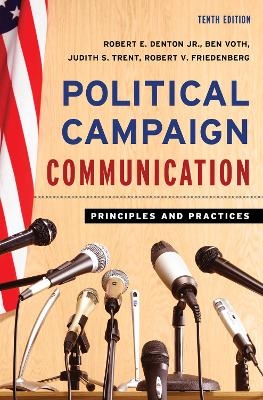
Political Campaign Communication
Rowman & Littlefield (Verlag)
978-1-5381-7144-8 (ISBN)
The tenth edition of Political Campaign Communication: Principles and Practices provides a clear and thorough survey of the strategic decisions vital to the success of contemporary political campaigns. The authors draw on a host of examples involving political campaigns at local, statewide, and national levels to illustrate all aspects of campaign communication, from forms of public address to buttons, yard-signs, and billboards, to traditional media and the use of internet and social media platforms. Throughout the volume they draw on communication theories to clearly explain contemporary political campaign practices.
Updated to reflect most recent practices and events from the 2020 presidential campaign, the book also considers journalistic practices and ethical considerations of today.
Features of the tenth edition:
Updates to reflect data on the 2020 election cycle
Updated and expanded discussion of social media platforms and practices
New art and graphics program to engage students and increase information retention
Expanded discussion of the history, practice, and state of journalism today
New chapter on local campaigns
Robert E. Denton Jr. holds the W. Thomas Rice Chair of Leadership Studies in the Pamplin College of Business and is professor in the Department of Communication at Virginia Tech. He has degrees in political science and communication from Wake Forest University and Purdue University. In addition to numerous articles, essays, and book chapters, he is author, coauthor, or editor of thirty books, several in multiple editions. Ben Voth is associate professor and director of speech and debate at the SMU Dedman College of Humanities and Sciences. He is author of Rwanda Rising: Debate as an Empowering International Pedagogy and the Rhetoric of Genocide: Death as a Text, as well as co-author with Robert E. Denton of Social Fragmentation and the Decline of American Democracy: The End of the Social Contract. Judith S. Trent was professor emerita of communication at the University of Cincinnati. She was the author of numerous books, book chapters, and journal articles. She wrote and spoke widely on the subject of political campaign communication and was a frequent commentator and analyst on political campaigns and candidates for the ABC, NBC, and CBS television affiliates in Cincinnati, as well as Ohio/Cincinnati newspapers. Robert V. Friedenberg is professor emeritus of communication at Miami (Ohio) University. He is the author of numerous books, book chapters, and articles. He has served as a communication consultant for the Republican National Committee and has been involved in more than seventy political campaigns.
Preface
1 The Campaign Communications Landscape
Importance of Political Campaigns
Changes in the Political Campaign
Decline of Political Parties
Finance Reforms
Political Action Committees
Technology
Communication and Political Campaigns
Essential Elements of Political Campaigns
Organization and Preview of Chapters
2 Communicative Functions of Campaigns
First Political Stage: Surfacing
Demonstrating Fitness for Office
Initiating Political Rituals
Learning about a Candidate
Developing Voter Expectations of a Candidate’s Style
Determining Main Campaign Ideas
Selecting Serious Contenders
Establishing Candidate-Media Relationships
Second Political Stage: Primaries
A Source of Feedback for the Candidates
A Source of Information for Voters
Citizen Involvement in the Political Press
Promises Made in Personalized Settings
Determination of the True Front-Runners
Third Political Stage: Nominating Conventions
The Evolution of Change of Political Conventions
Reaffirming and Legitimizing the Electoral Process
Legitimizing the Party Nominees
Demonstrating Party Unity
Introducing the Candidate’s Campaign Themes and Issues
Fourth Political Stage: The General Election
Gaining Information
Legitimizing the Political System
Meeting Campaign Expectations
The Fifth Political Stage: Post Election
Conclusions
3 Communicative Styles and Strategies of Campaigns
Preliminary Considerations
Style
Image and Campaign Style
Technology and Campaign Style
Styles and Strategies of Campaigns
Incumbency Style
Symbolic Strategies
Symbolic Strategies of the Office
Legitimacy of the Office
Competency and the Office
Charisma and the Office
Pragmatic Strategies
Creating Pseudoevents
Making Appointments to Jobs and Committees
Creating Special Task Forces
Appropriating Funds/Grants
Consulting with World Leaders
Manipulating Important Domestic Issues
Receiving Endorsements from Other Leaders
Emphasizing Accomplishments
Creating an Image of Being Above the Political Trenches
Interpreting or Intensifying Foreign Policy Problems into International Crises
Summary
Disadvantages to Incumbency Campaigning
Challenger Style
Attacking the Record
Taking the Offensive Position on Issues
Calling for a Change
Emphasizing Optimism for the Future
Taking the Offensive Position on Issues
Calling for a Change
Emphasizing Optimism for the Future
Speaking to Traditional Values
Appearing to Represent the Philosophical Center
Delegating Personal or Harsh Attacks
Summary
Incumbent/Challenger: A Merger of Styles
Conclusions
4 Communicative Mass Channels of Campaigns
Early Studies
Early American Adaptation of Public Relations and Propaganda
Hypodermic Effect
Limited Effects or the Social Influence Model
Contemporary Studies
Diffusion of Information
Uses and Gratifications
Elaboration Likelihood
Agenda-Setting Hypothesis
Reconceptualization of the Classics
21st Century Mass Channels of Political Campaign
Conclusions
5 Communicative Types and Functions of Televised Campaign Advertising
Historical Development
Understanding Theory and Praxis Regarding Televisual Attack and Defense
Ads Extolling the Candidate’s Virtues
Ads Condemning/Attacking/Questioning the Opponent
Ads Responding the Attacks or Innuendos
Final Questions: How Effective Is Television Advertising and Do Televised Attack Ads Work?
Does Money Equate to Effectiveness in Advertising?
Televised Comedy as Political Advertising
Conclusions
6 Ethical Considerations of Campaign Communication
Age of Citizen Mistrust, Polarization, and Cynicism
A “Philosophy” of Political Campaign Ethics
Campaigns and Ethics
Ethical Pivots
Areas of Ethical Concerns in Political Campaign Communication
News Media and Journalism
Political Advertising
Rejecting the False Model of Political Campaign Ethics: Alinsky
Toward a Model of Political Campaign Communication Ethics
Conclusions
7 Public Speaking in Campaigns
The Decision to Speak
Audiences
Messages
Competency and Format
Campaign Messages
Incumbent/Challenger Strategies
The Speech
Need and Justification
Stock Speeches: Utilizing Speech Modules
Speech-Like Opportunities and Modular Speech
Speaking Style: Extemporaneous or Prepared
Stock Speeches: The Basic Stump Speech
Stock Speeches: The “Why I am Running” Speech
Political Speechwriting
Justification and Implications of Political Speechwriting
Job Demands
Speechwriting Teams
Methods of Political Speechwriting
Surrogate Speakers
Selection of Surrogates
Benefits of Surrogates
Viral Speech Videos
Conclusions
8 Recurring Forms of Political Communication
Announcement Speeches
Preannouncement Situation
Purpose of Address
Strategies of Address
Acceptance Addresses
Situation during Address
Purpose of Address
Strategies of Address
Using Simplified Partisan Statements
Lamenting the Present while Celebrating the Future
Stressing the Crucial Nature of the Election
Calling for Unity
Using Biography
Using Biography to Go Negative
Summary
News Conferences
Situation for News Conferences
Purposes of News Conferences
Strategies of News Conferences
Apologias
Situation for an Apologia
Purposes of Apologia
Strategies of Apologia
Control of the Apologia Setting
Denial
Bolstering
Differentiation
Transcendental Strategy
Confession
Summary
Conclusions
9 Debates in Campaigns
History of Political Debates
Deciding Whether to Debate
Political Debate Strategies
Pre-Debate Strategies
Lowering Public Expectations
Determining the Target Audience
Devising and Rehearsing Possible Answers
Determining the Target Audience
Devising and Rehearsing Possible Answers
Debate Strategies
Relating Issues to an Overall Theme
Developing an Image
Post-Debate Strategies
Offering a Large, Well-Coordinated Surrogate Effort
Using Ads to Underscore Debate Themes
Using Audience Members to Project a Positive View
Effects of Political Debates
Increased Audiences
Reinforce Audience Opinions
Shift Limited Numbers of Voters
Help Set Voters’ Agenda
Increase the Voter’s Knowledge of Issues
Modify Candidate Images
Build Confidence in U.S. Democracy
Suggestions for Improving Presidential Debates
Conclusions
10 Interpersonal Communication in Campaigns
Interpersonal Communication between Candidate and Voters
Micro-targeting
Special Events
Public Appearances
Dinners
Coffees and Receptions
Door-to-Door Canvasses
Phone Banks
The Internet
Interpersonal Communication between the Candidate and Prospective Financial Contributors
The Importance of Individual Contributors
The Role of Attraction
Interpersonal Communication between Voters
Importance
Discussion Topics
Interpersonal Communication among Voters, Mass Media, and Voting Behavior
Interpersonal Communication and Getting-Out-the-Vote Efforts
Behavioral Characteristics of Successful Interpersonal Campaigners
Conclusions
11 Advertising in Campaigns
Developing a Master Plan for Political Advertising
Basic Considerations in the Selection of Political Advertising Media
Direct Mail
Telephone Contact Services
Radio
Television
The Internet
Making Television Ads
Targeting of Television Ads
Campaign Advertising Strategies
Media Concentration and Media Dispersion
Continuity Scheduling, Flight Scheduling, and Pulse Scheduling
The Spurt Strategy
The Fast Finish Strategy
The Really Big Show Strategy
The Cruise Control Strategy
Media and Other Types of Political Consultants
History of Political Consulting
Functions of Political Consultants
Writers
Speech Coaches
Direct Mail Specialists
Conclusions
12 The Internet and Social Media in Campaigns
Historical Overview of Campaigns and New Communication Technologies
Social Media in Campaigns
Social Media and Digital Strategies
Blogs
Email
Mobile Devices
Text Messaging
Web 2.0
Social Media
Facebook
YouTube
MySpace
Twitter
Pinterest
Tumblr
Reddit
Snapchat
Instagram
TikTok
ChatGPT
Conclusions
13 Journalism and Fake News in Campaigns
The Transition of American Journalism
Sources of Political News
Trust in News
How Media Cover Presidential Campaigns
The Path to Fake News and Misinformation
Effects of Fake News and Misinformation
Identifying Fake News and Misinformation
Conclusions
14 Campaigning for Local Elections and Offices
Early Considerations
Campaign Organization
Campaign Plan
Campaign Messaging
Slogans
Campaign Colors
Logo
Issues
Opposition Research
Media and Tactics
Announcing Candidacy
Candidate Coffees and Receptions
Trinkets
Yard Signs
Letters
Flyers and Handouts
Door to Door/Neighborhood Walks
Literature Drops
Debates
Media Coverage
News Releases
News Conferences
Letters to the Editor
Editorial Boards
Direct Mail
Broadcast Media
Internet/Web
Conclusions
Index
About the Authors
| Erscheinungsdatum | 03.11.2023 |
|---|---|
| Verlagsort | Lanham, MD |
| Sprache | englisch |
| Maße | 180 x 255 mm |
| Gewicht | 839 g |
| Themenwelt | Sozialwissenschaften ► Kommunikation / Medien ► Kommunikationswissenschaft |
| Sozialwissenschaften ► Politik / Verwaltung ► Staat / Verwaltung | |
| ISBN-10 | 1-5381-7144-9 / 1538171449 |
| ISBN-13 | 978-1-5381-7144-8 / 9781538171448 |
| Zustand | Neuware |
| Haben Sie eine Frage zum Produkt? |
aus dem Bereich


